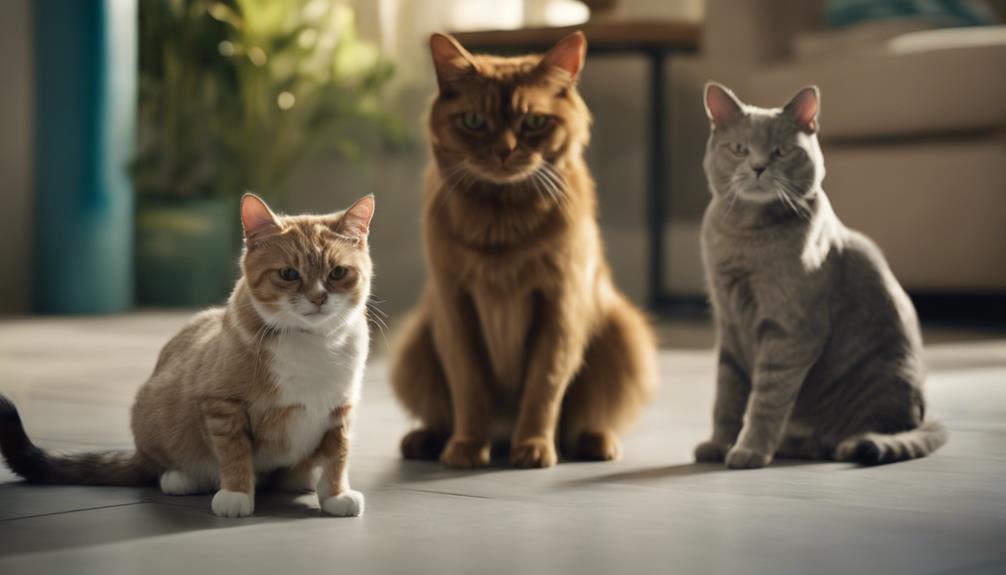Do Cats Prefer Socializing With Certain Animals?

Cats are known for being solitary animals, but they can also form social bonds with other animals under the right circumstances. Factors influencing feline social preferences include the individual cat's personality, past experiences with other animals, and the specific species or breed of the other animal. For example, some cats may prefer the company of other cats if they have been raised together from a young age, while others may enjoy socializing with dogs or even small animals like rabbits. Understanding these factors can help cat owners create a harmonious environment for their pets.
Research has shown that cats are capable of forming complex social relationships with both humans and other animals. By providing opportunities for positive interactions and respecting their individual preferences, cat owners can help their feline companions lead happy and fulfilling lives.
Types of Animals Cats Socialize With
Cats typically socialize with other animals in their environment, such as dogs, birds, and even small rodents. When it comes to animal hierarchy, cats usually establish clear boundaries and pecking orders when interacting with different species. Despite their independent nature, cats can form interspecies friendships under the right circumstances. These relationships are often based on mutual respect and understanding rather than dominance.
In some cases, cats may view dogs as part of their social circle, especially if they've been raised together from a young age. Dogs and cats can develop strong bonds, engaging in playful activities and even grooming each other. Birds, on the other hand, may pique a cat's curiosity but can also serve as companions in a shared living space. Small rodents, like mice or gerbils, may trigger a cat's hunting instincts, leading to a more complex dynamic based on predator-prey relationships. Understanding the nuances of these interspecies interactions can help pet owners create harmonious environments for their animals.
Factors Influencing Cat Socialization

Factors influencing cat socialization include:
- Animal compatibility factors
- Socialization patterns in cats
Understanding how cats interact with other animals and identifying the specific elements that contribute to successful socialization can help cat owners create environments that foster positive social interactions for their feline companions.
Animal Compatibility Factors
Understanding the dynamics of animal compatibility is crucial in determining the success of cat socialization efforts. When considering animal behavior and friendship dynamics, several factors come into play. Here is a table highlighting key factors influencing cat compatibility with other animals:
| Compatibility Factor | Description |
|---|---|
| Species Differences | Cats may have specific preferences for interacting with certain species. |
| Temperament Matching | Matching personalities between animals can promote positive social interactions. |
| Environmental Enrichment | Providing a stimulating environment can facilitate bonding between animals. |
Socialization Patterns in Cats
When considering the dynamics of cat socialization, it's essential to recognize the intricate patterns that influence their interactions with other animals. Feline friendships aren't solely based on species; individual personalities, early social experiences, and environmental factors play significant roles.
Cats may form close bonds with other cats, dogs, or even small animals if introduced properly and given time to adjust. Inter species interactions among cats can vary from playful companionship to tolerant cohabitation.
Factors like age, sex, and social hierarchy within a group can impact how cats socialize with each other and with different species. Understanding these patterns can help pet owners create harmonious environments for their cats and facilitate positive social interactions among animals in their care.
Signs of Cat Preferences in Socializing

Cats often display their social preferences through subtle body language cues when interacting with other cats or humans. Behavioral cues, such as tail position, ear movements, and vocalizations, play a significant role in determining a cat's comfort level and interest in socializing. Understanding these behavioral cues can help individuals gauge whether their feline companions are enjoying the company of others or if they prefer solitude. Communication styles also vary among cats, with some being more vocal and seeking attention, while others may prefer non-verbal forms of interaction, like head butting or gentle nudges.
| Behavioral Cues | Description |
|---|---|
| Tail Position | Upright and relaxed may indicate interest |
| Ear Movements | Forward-facing ears show engagement |
| Vocalizations | Meows can signal either friendliness or annoyance |
| Body Posture | Relaxed posture indicates comfort |
| Eye Contact | Direct eye contact can be a sign of trust |
Introducing Cats to New Animal Companions

Upon introducing cats to new animal companions, it's crucial to create a gradual and controlled environment that promotes positive interactions and reduces potential stressors. Playful introductions can help cats feel more at ease with their new companions. Supervised initial interactions, where both animals have their own space to retreat to if needed, are essential.
Positive reinforcement, such as treats or gentle praise when the animals interact calmly, can encourage desirable behavior. Slowly increasing the time the animals spend together allows them to become accustomed to each other's presence. It's important to watch for signs of discomfort or aggression and intervene if necessary. Providing separate resources like food bowls, litter boxes, and resting areas can prevent competition and reduce tension.
Understanding Cat Body Language in Interactions

Understanding cat body language in interactions is crucial for interpreting their feelings and intentions. Tail position can convey a lot about a cat's mood, with a high tail often indicating confidence and a low tail potentially signaling fear or submission.
Additionally, eye contact plays a significant role in feline communication, with prolonged staring being seen as confrontational in cat social interactions.
Tail Position Meanings
Interpreting a cat's body language through their tail position is crucial for understanding their social preferences and interactions. Cats use their tails as communication cues, conveying various emotions and intentions. A tail held high signifies confidence and a friendly demeanor, indicating a willingness to interact with other animals.
Conversely, a tail tucked between the legs signals fear or submission, suggesting discomfort in a social situation. When a cat's tail is twitching rapidly, it may indicate agitation or excitement, which could impact their interactions with other animals.
Understanding these tail position meanings can help individuals gauge a cat's receptiveness to socializing and tailor their approach accordingly, fostering positive interactions and relationships between cats and other animals.
Eye Contact Significance
When a cat engages in eye contact during interactions, it holds significant meaning that can provide insights into their social intentions and emotional state. Understanding a cat's eye contact can help decipher their communication cues effectively.
- Pupil Dilation: Dilated pupils often indicate heightened arousal or excitement, potentially signaling a desire for interaction.
- Body Language: Observing the cat's overall body language in conjunction with eye contact can reveal whether they're feeling relaxed, tense, or playful.
- Vocalization Cues: Cats may accompany eye contact with various vocalizations, such as purring, meowing, or hissing, which can further indicate their social behavior and emotional state.
Tips for Encouraging Positive Animal Relationships

Encouraging positive animal relationships can be achieved through consistent training and positive reinforcement techniques. When introducing a cat to a new animal companion, playful introductions and positive reinforcement are key. It's essential to create a safe and controlled environment for the initial interactions. Building trust between the animals is crucial, and this can be done by offering treats and praise for calm and friendly behavior towards each other.
Gradual exposure is also vital in fostering positive relationships between animals. Slowly increasing the time they spend together can help prevent any potential conflicts or stress. It's important to monitor their interactions closely and intervene if signs of aggression or discomfort arise. Providing separate spaces for each animal to retreat to is beneficial in allowing them to have their own safe zones.
Seeking Professional Advice for Cat Socialization

Professional guidance is invaluable when seeking to socialize cats effectively. Cat behaviorists, backed by research studies, offer expert opinions on socialization techniques that can help cat owners navigate the complexities of feline interactions. Here are three crucial points to consider when seeking professional advice for cat socialization:
- Consulting Cat Behaviorists: Cat behaviorists, who specialize in understanding feline behavior, can provide tailored advice based on your cat's unique personality and needs. Their insights can help create a socialization plan that suits your cat's temperament.
- Research-Backed Socialization Techniques: By staying informed about the latest research studies on cat behavior and socialization, cat owners can incorporate evidence-based practices into their efforts to help their cats socialize effectively.
- Expert Opinions on Introducing Cats to Other Animals: Professionals can offer guidance on introducing cats to other animals, such as dogs or other cats, in a controlled and positive manner to facilitate healthy relationships and reduce stress for all animals involved.
Frequently Asked Questions
Can Cats Socialize With Animals Other Than Dogs and Other Cats?
Cats can socialize with a variety of animals beyond dogs and other cats. They may enjoy companionship with exotic animals, forming unique bonds. Cats can also build relationships with farm animals, demonstrating diverse social behaviors based on individual preferences.
Are There Specific Breeds of Cats That Are More Sociable With Other Animals?
When it comes to inter-species friendships, some breeds of cats exhibit higher levels of sociability with other animals. Breed compatibility plays a role in determining which cats may be more inclined to socialize with different species.
How Do Outdoor Versus Indoor Cats Differ in Their Socialization With Other Animals?
Outdoor cats, particularly feral cats, often display more independence and limited socialization with other animals compared to indoor cats. The outdoor environment can influence their interactions and comfort levels with different species.
Can Cats Develop Friendships or Alliances With Certain Animals Over Time?
Cats can develop close bonds with certain animals over time, forming unique interspecies friendships. Their behavior in these animal interactions showcases their ability to create meaningful connections that go beyond the typical socialization patterns.
Do Cats Show Preferences in Socializing Based on the Gender of the Other Animal?
When it comes to socializing, cats may exhibit gender dynamics, showing preferences in their interactions. Behavioral patterns can vary based on the gender of the other animal, influencing their socialization choices and alliances over time.










